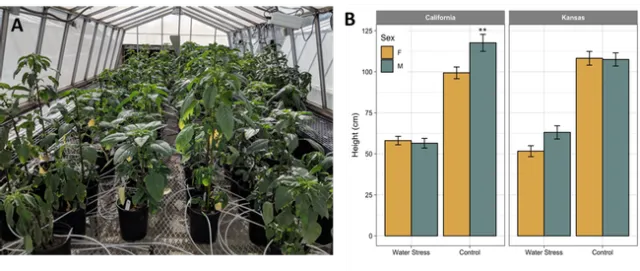Under pressure: cross-generational communication in Palmer amaranth
The environmental conditions under which parental plants are grown can affect the progeny population in many ways. Extreme abiotic environmental conditions such as high temperatures, water stress, nutrient deficiency and herbicide application not only will affect the attributes of the parental plants (e.g. biomass and seed production) but also likely to transcend the next generation characteristics (e.g. progeny germination rate and vigor). As plants are sessile organism, progenies will most likely grow in the same environment as their parents. The mechanism of parental effect is very important for the successful establishment of the next generation especially in annual plant species, were parents and progenies do not exist at the same time preventing direct cross-generational communication.
In a recent study conducted in the Mesgaran lab at UC Davis, using Palmer amaranth (Amaranthus palmeri S. Watson) as a model system, we tested the effects of drought during the growth of parental plants on different parameters of the progeny seed. We grew two populations (from California and Kansas) under continuous water-deficit (WD, 25-33%) or well-watered (WW, 100%) conditions. When reached the reproductive stage, plants of both populations from each treatment were isolated and maintained in different greenhouses, seeds were collected for further characterization.

Plant height was significantly reduced in plants grown under water stress (Fig. 1A). Differences were pronounced in both female and male plants, with a difference of over 60 cm comparing the tallest plants grown under WW to the shortest plants grown under WD conditions (Fig. 1B). Higher and bigger plants can be more competitive thus increasing their light and nutrient harvesting capabilities, which, in turn, may also increase reproductive abilities. But the pivotal question is how these additional resources will be distributed and what would be the additional fitness gain for these plants?
Next, we have characterized the seeds of both parental and progeny from both California and Kansas populations.
![Figure 2. Differences in 100 seeds weight between parental (P) and progenies of two Palmer amaranth populations [California (A) and Kansas (B)] grown under continuous water-deficit (WD) or well-watered (WW) conditions.](/sites/default/files/styles/large/public/2019-02/blog58003.png.webp?itok=qhF2DsMX)
For both populations, progeny seeds were significantly heavier than the parental seeds (Fig. 2A and B). When we compared the 100 seeds weight of progeny between the watering treatments, seeds originated from plants grown under water-deficit were much heavier than the seeds from plants received normal irrigation. It can be argued that the maternal plants exposed to water stress allocated their very limited resources to the production of fewer but larger seeds that could be more competitive next year.
Further, we have tested the germination of seeds from all three seed groups (parent, WW and WD) for each population and compared their germination percentage under 30° C.
![Figure 3. Mean and standard deviation for the final germination percentage of parental (P) and progenies of two Palmer amaranth populations [California (A) and Kansas (B)] grown under continuous water-deficit (WD) or well-watered (WW) conditions.](/sites/default/files/styles/large/public/2019-02/blog58004.png.webp?itok=BNVPWNpo)
For both populations, germination percentage was the highest in seeds from plants that were grown under water-deficit conditions (Fig. 3A and B). Seeds of plants that were grown under normal irrigation conditions (WW), showed similar germination percentage in comparison with their parental seeds. This pattern of higher germination rate in seeds that were nurtured under WD conditions suggests that these seeds are less dormant. The “memory” of a stressful year communicated from the parent to the progeny through seed components (e.g. hormonal levels, endosperm volume and content) may be adaptive and help with the long-term survival of species.
Our results show that Palmer amaranth plants experiencing drought during their growth can produce less dormant, larger and perhaps more competitive seeds (vigorous seedlings). The cross-generational communication between parents and progenies may improve the fitness of the new generation and increase its success under extreme environmental conditions. Several studies are being conducted in the Mesgaran lab to better understand the fitness consequences of parent-progeny dialogue and learn more about seed germination under extreme environmental conditions.
For more information please contact Mohsen B. Mesgaran, mbmesgaran@ucdavis.edu.
Maor Matzrafi, Sara Ohadi, and Mohsen B. Mesgaran are with the Department of Plant Sciences at the University of California, Davis.
